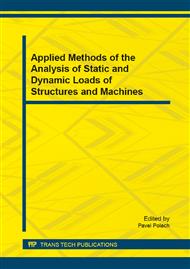p.149
p.153
p.161
p.165
p.171
p.175
p.179
p.183
p.187
Estimation of Crack Depth and Profile Using DCPD Method in Full Scale Railway Axle Loaded by Rotating Bending
Abstract:
The paper contains results of a study aimed at exploring possibilities of use of direct current potential drop (DCPD) method for evaluation of depth and profile of cracks occurred under or near press fitted hubs in a full-scale axle during severe rotating bending loading. DCPD method was applied on section of an axle after fatigue by a specific way and potentials were measured in several circumferential areas of the axle section, when direct current passed longitudinally. Results are analysed and discussed. It was indicated that unlike previous use of the method for crack measurement of different components, even large and complicated, described in the literature, when potentials corresponded to ratio of cracked and uncracked area, in this case of approximately circumferential crack, measured potentials correspond better to relative crack depth in the relevant point of the circumference.
Info:
Periodical:
Pages:
171-174
Citation:
Online since:
February 2015
Authors:
Keywords:
Price:
Сopyright:
© 2015 Trans Tech Publications Ltd. All Rights Reserved
Share:
Citation:


